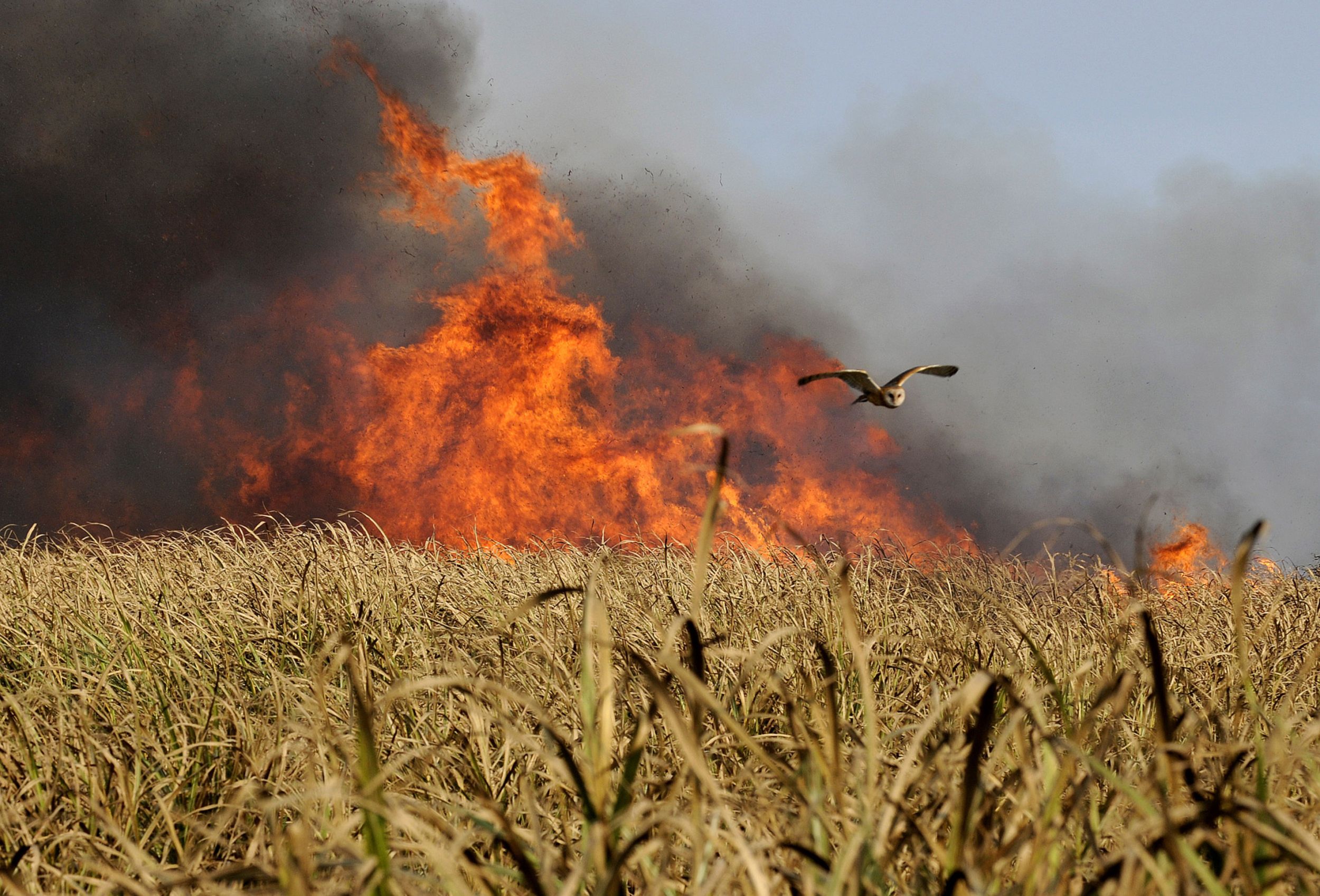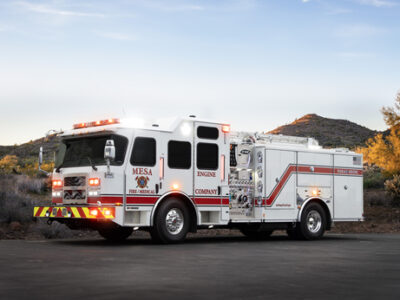By Paul Tullis
Mar 28, 2020, 7:00 AM – Updated on Apr 1, 2020, 11:39 AM
Driving west on Florida Route 98 from Palm Beach, the smoke is visible before the warning signs. Near theLion Country Safari (“Florida’s only drive-through safari”), there are, far across a vividly-green expanse, dark gray clouds climbing into the sharp-blue sky. A minute later, by the roadside, comes the announcement, courtesy of the state transportation authority: “REDUCED VISIBILITY POSSIBLE.” If the immediate danger isn’t present, it’s nonetheless clear: You’re entering sugar country.
On the following November day, about 50 miles west, a John Deere tractor towing a water tank rumbles through a narrow dirt path between two cane fields, or “blocks,” as the sugar growers call them. Behind the tank, a man stands holding a fire-starting device called a driptorch. The tractor’s driver sprays water on the block to its left so it won’t ignite—flowers have not yet formed at the tops of the stalks to indicate they are ready for harvest—while the man in the rear sets fire to the one on the right. The driver covers his airways with a bandana; the firestarter has chosen not to.
South of Lake Okeechobee is home to the largest concentration of sugar plantations in the U.S. About 25% of the U.S. harvest is grown here, sold under brands including Domino and providing ingredients to food manufacturers and grocery chains. Florida’s sugar farmers burn fields to clear them of excess organic material—“trash,” in industry parlance—making harvesting more efficient. The leaves, containing virtually no sugar, go up in smoke, while the sucrose-laden stalks, being about 72% water, don’t. Studies in Mexico have demonstrated that constituents of the smoke from burned sugar cane include black carbon, which has powerful global warming effects, as well as dangerous particulate matter and potential carcinogens, including benzo[a]pyrene. Some residents of Florida sugar country see a link between what seems like a lot of kids using inhalers and the October-to-May harvest season.
A sugar cane field burns like the guy in Hemingway’s The Sun Also Rises went broke: gradually, then suddenly. Flame is touched to the drier stalks near the ground, and within seconds crackling can be heard as the water inside them warms to a boil, forming bubbles that then pop. The popping grows louder and more frequent as the fire spreads. The flames, reaching 30 to 40 feet, gather a roaring wind as they suck in oxygen to feed themselves. The smoke is so dense in places as to be opaque. Undeterred, egrets accumulate near the block’s edge to ambush fleeing insects. After several minutes, the fire is over, and the block is now “clean.” If all goes according to plan, the smoke rises high above the cane stalks and dissipates quickly. Sometimes, though, it lingers at ground level, thick enough that if you drove your car into it, you’d be blinded. Here, the smoke has drifted south and all is quiet again.
“You burn so the trash doesn’t go to the mill,” says Alan Hammock. He’s been working for 46 years on land his uncle began to till more than a century ago. He and his wife, Ardis, own 700 acres.
“Whatever leaf material gets to the mill is deducted from the total you sent in,” Alan says. If he delivers 100 pounds and 10 pounds of it is leaf, he only gets paid for 90 pounds. He takes a look at the results and pronounces today’s burn “picture perfect.”
Alan grabs a rusty cane knife and chops a stalk from a block belonging to a neighbor. Peeling away the skin to reveal the sugar-laden fiber, he pops a chunk in his mouth. “Man!” he exclaims. “These people’s making some money right here!”
No doubt about that: Florida companies turned cane from farmers such as the Hammocks into $630 million worth of sugar in 2017. Their economic impact is $3 billion, according to agribusiness market intelligence firm LMC International, and they support more than 12,000 jobs. That year, Florida’s Forest Service, which regulates agricultural burning, received more than 11,000 applications for permits to burn sugar fields, according to a document obtained through a Freedom of Information Act request. More than 95% were approved.
Driving back to the Hammocks’ home, Alan says, “If I thought we were being detrimental to the community or the atmosphere, I wouldn’t be in [cane farming].” He peers up. “It looks like blue skies to me. A little bit of smoke and ash is just gone in no time.” Ardis points to the house where her grandchildren live, circled on three sides by cane. “Why would I put my children in harm’s way knowing that was going to affect their health?”
The smoke contains a lot of chemicals that linger, though. Sugarcane burning is estimated to contribute more than half of Palm Beach County’s total emissions for 15 hazardous air pollutants. From 2003 to 2007, 17% of the contiguous United States’ crop-burning emissions of carbon dioxide, 10% of the methane and 15% of 2.5-micron particulate matter occurred in Florida. (Carbon dioxide and methane are greenhouse gases. Particulate matter-2.5 is an ingredient in smog that closely correlates with increased mortality.)
Dozens of scientific studies have purported to show harm or risk to the health of those who live near sugarcane fields in Brazil, Mexico, Hawaii, Louisiana and elsewhere, and concluded that eliminating the practice led to improved health outcomes.
Cane fields run up to the property lines of homes, schools, stores and businesses throughout Clewiston, Belle Glade, South Bay and Pahokee, small towns that hug the shore of Lake Okeechobee and are home to many industry workers. Children at Rosenwald Elementary, which borders a sugar field, were sent to the hospital at least once in 2008 after smoke from a bordering block didn’t dissipate as anticipated; they and students at other schools, residents say, often visit the school nurse to use a breathing machine. (Florida’s Department of Health, which administers nurses in the state’s public schools, did not respond to repeated requests for an interview with a nurse in the Glades area.)
“It was normal to us growing up,” says Kina Phillips, an anti-burn activist whose child attended Rosenwald and who lives nearby. “‘Kina—go get your inhaler and go play.’ Why? Why should our schools be so filled with inhalers?” A woman who says she has lived in the area for 23 years and had a child in February 2019, told lawyers that in April her son was diagnosed with asthma. “He’s suffering from wheezing, breathing problems,” she says. “I just wish they could really stop the burning because my child is suffering.” (Bloomberg was unable to independently verify her statement.)
Shanique Scott, the former mayor of South Bay, owns a kids’ dance studio in town. “Just in the past month, three of my kids have been out because they’re dealing with asthma problems—their parents taking them to the doctor for respiratory problems flaring up because it’s the [burning] season,” she said in November.
Five years ago, when she was the mayor, Scott tried to get city commissioners to do something about the burning, but they declined to join her in speaking out. Frustrated, she called the Sierra Club and asked for help. Later that year, the group launched a “Stop the Burn” campaign in the area. It hasn’t been able to attract more than a few dozen residents to become active in it, but in 2018, attorneys filed a class-action lawsuit against nine sugar growers and harvesters, calling for compensatory damages, medical monitoring of the plaintiffs and an injunction against further burning. If the judge approves class-action status, some 28,000 residents could be represented. The defendants have filed a motion to dismiss the suit; the judge has not set a date for a hearing. “The companies believe the lawsuit is without merit,” Ryan Weston, CEO of the Sugar Cane League, which represents the three largest growers and processors in Florida, wrote in an email. (Florida Crystals and the other named defendants declined to make any employees available for an interview; a U.S. Sugar spokeswoman answered questions via email.)
The lawyers and activists such as Scottmaintain they aren’t trying to put the industry out of business, just to get it to change its practices. There is an alternative to burning, and Florida sugar growers are already doing it—at least in a few fields. Known as green harvesting, mechanical harvesters collect the trash, which can be sold for fuel pellets or to generate electricity,or it’s left in the fields.
The fields bordering the Walmart in Clewiston are harvested green to prevent smoke from bothering the customers in the parking lot, according to the guide of a tour of the area organized by the Clewiston Chamber of Commerce. (Judy Sanchez, senior director of corporate communications and public affairs for U.S. Sugar, said these fields are “harvested via controlled pre-harvest burn techniques whenever the conditions meet the requirements for obtaining a permit.”)
Legions of farmers abroad have switched to green harvesting. Mills that account for 63% of the annual harvest in Brazil agreed in 2007 to phase out cane burning within a decade, and carbon dioxide emissions dropped by almost 10 million tons. Most of Australia’s $1.37 billion industry no longer burns. Thailand announced in August that it would end burning within three years out of concern for the smog in cane-producing provinces.
But Florida’s sugar industry insists green harvesting wouldn’t work in its “muck” soils, made up of decayed organic matter from when the cane fields were swampland. Regions overseas that are moving away from burning, Ardis Hammock tells me, “don’t have the same soil types we do. If you leave dense plant matter on the rows, it blankets over the shoot. Trying to sprout with a blanket of trash on top, it’s the perfect scenario for funguses.”
But years-long experiments led by researchers at the University of Florida’s Institute of Food and Agricultural Sciences have shown that the shoots fight through the trash and grow to produce about as many tons of sugar as in cane fields that have been burned. Other research has confirmed this, and Andrew Wood, an Australian expert in green harvesting, studied Florida’s industry and concluded that green harvesting would result in higher profits for the industry, despite the unique soil.
Even so, switching all 400,000 acres of Florida sugar to green harvesting would be a major expense: Additional harvesters would be required to handle the extra material, along with more wagons to carry it off, more workers to operate the additional equipment and more fuel to run it all. All this, plus the trucks rolling through town to haul off the trash that isn’t left in the field, would mean more diesel pollution in the four towns. Ardis Hammock and the director of IFAS, Gregg Nuessly, questioned whether there is a market for converting the trash into paper and packaging, though the managing director of Emerald Brand, which makes plant-based paper and plastic products, Ralph Bianculli, Jr., says, “We could probably use this material.”
Sugar wields plenty of power in Florida, and there’s little incentive to change. The industry gave more than $8 million to political candidates in the 2016 election cycle. Growers are convinced that their work benefits the area. “We haven’t seen any facts that would make us want to change our mind,” about burning, says Miller Couse, chairman of the board of First Bank in Clewiston, which provides agribusiness loans in the region.
Whether residents believe that cane burning harms the health of the surrounding communities seems to depend on where they live and on the color of their skin. Clewiston is majority white; South Bay, Belle Glade and Pahokee are majority black.
All the white Clewiston residents and community leaders I meet during five days I stayed in town tell me they don’t know anyone who has asthma. The mayor, Mali Gardner, tells me about how her mother is 91, her aunt 88, and her dad passed at 93.
Couse and industry representatives point to data showing favorable air quality in the Glades. But Florida’s Department of Environmental Protection operates just one monitor in the region, in Belle Glade, which collects data on just one pollutant, PM2.5. (Not, for example, on such polycyclic aromatic hydrocarbons as benzo(a)pyrene, which have been found at levels 15 times higher during the burn season as in the summer.) The device is a “non-regulatory” monitor, meaning it has not been approved by the U.S. Environmental Protection Agency to determine compliance with national ambient air-quality standards. The data it reports average out pollution over a time frame too broad to pick-up short-term spikes—such as field burns. The industry pays for additional monitors to ensure compliance with regulatory standards. Maps of areas that may be impacted by smoke, which the Forest Service produces daily, indicate smoke can travel up to 26 miles.
I met only one black person who wasn’t convinced that sugarcane burning is poisoning the Glades communities. Eric Green, assistant coach of the Clewiston High School football team, says that in five years, he has supervised only one player who needed an inhaler.
Steve Messam has had a different experience. “Growing up here, I always breathed heavy as a child,” he says. Returning from college in Michigan over Christmas break as a freshman, he noticed he felt worse. Years later, he lived with his wife and son east of the Glades, but when they moved to Belle Glade, Messam says, his son started having trouble breathing (though he has not been diagnosed with asthma). Messam’s wife, who, like him, is black, started experiencing upper respiratory tract infections. When they go to Orlando on vacation, or to Jamaica to visit family, the problems disappear.
The divide between the anti-burning camp and supporters of the status quo seems to be so sharp that Couse tells me, “I don’t know of any local opposition. I don’t know any local people raising any fuss about the burning of cane.”
This has perhaps contributed to the widespread belief that the opposition to burning is led by people from outside the Glades communities. Still, the Sierra Club says its involvement didn’t begin until Scott called. And Matthew Moore, the Berman Law Group attorney heading the class-action suit, tells me his firm became interested in the issue only after hiring Joe Abruzzo, a former state senator who represented the area.
Whether you are bothered by smoke also depends on where you live. Household income in Pahokee, Belle Glade and South Bay is about half Florida’s median, and its unemployment rate is higher. Wealthier, whiter communities east of the Everglades Agricultural Area don’t experience burning anymore: In the 1990s, residents in eastern Palm Beach County complained, and now the state won’t issue burn permits when the weather forecasts that wind will blow toward their homes. (In some cases, with special authorization, it is allowed.)
“The more affluential folks started complaining about it, and they gave them the courtesy. They won’t burn,” says Messam. “But they won’t give us, who live in the middle of these fields, the same courtesy.” The area with the fewest restrictions on burning includes all four Glades towns. “They’re not allowed to burn when it’s going into civilized areas,” is how the former mayor of Pahokee, J.P Sasser, sarcastically puts it.
The zone map system for permits seems to implicitly acknowledge that smoke is dangerous, or at least bothersome, and rule changes in October instituted a buffer zone between sugar burns and wildlands. Florida’s Department of Health recommended in 2013 that schools and daycare centers near busy roadways limit children’s exposure to air pollution.
Florida Department of Agriculture and Consumer Services Commissioner Nikki Fried says in an interview that “one of the things we’re taking into consideration” during a second phase of changes, to be rolled out in 2020, is redrawing the zone map that allows burn permits to be issued only when wind is blowing toward the lower-income, majority-black communities and Clewiston. Forest Service Director Jim Karels echoes those in the industry who continually tell me that, the permit zone map notwithstanding, wind speed, direction and other factors are always taken into account when burn permits are issued. But as anyone who has ever been caught without an umbrella can tell you, forecasts often miss the mark.
The experience of Clewiston’s white residents—and the other cities’ black residents—are anecdotal. They don’t constitute meaningful data. Florida’s Department of Health tracks measures such as asthma hospitalizations; Palm Beach County as a whole, which encompasses both Belle Glade and Mar-a-Lago, ranks fifth in the state for the rate of asthma hospitalizations—ahead of Broward and Miami-Dade, which have both more poverty and more traffic, two predictors of asthma in an area.
But another predictor of asthma is whether or not you are black. Tending to have less access to health care, more likely to be poor than whites and more likely to face exposure to environmental toxins, black Americans have higher rates of asthma and—even controlling for socioeconomic factors—they are more difficult to treat. Could the exposure of Glades residents to cane burning fundamentally reflect their genetic makeup and socioeconomic status?
Matthew Moore, the attorney leading the class-action suit, says he will present to the court data showing 2.5 times higher rates of hospitalizations for pulmonary issues in zip codes where burning occurs, compared with the rest of Florida.The hospitalization figure is a crude measure: Some people might seek treatment at a doctor’s office, or not at all, meaning the prevalence of the disease could be more widespread than public health data is picking up. Dr. Sally Wenzel, director of the Asthma Institute at University of Pittsburgh Medical Center, says that “The only way to answer the question” as to whether sugarcane burning is the direct cause of the respiratory issues that residents experience “is with a better level of granularity—to do a person-based study, as opposed to a population-based study” such as the ones published so far.
Those studies are expensive, though. This is an area with little air quality monitoring, low household income, and a high proportion of minority residents. Who would pay for it? The sugar companies earn hundreds of millions in annual revenue and receive $1.2 billion in annual subsidies from the federal government to prop up prices. But why would it want to invest in what could be bad news? In any case, funding from an entity with so clear an interest in the findings could bias the results.
“People take it as just, this is what it is down here,” says Steve Messam. “It’s part of the daily grind.” But Messam is a pastor and a life coach—he’s passionate and he has a vision for the Glades that includes residents earning good wages by producing environmentally friendly disposable products from cane trash. “My dad cut cane for 75 cents a row, by hand,” he says. “Now we’ve progressed. Why use these archaic methods? I just want them to be good neighbors.”





